






 |
|||||||
 |
 |
 |
 |
 |
|||
 |
|||||||
|
Power Triodes "A triode is an electronic amplifying vacuum tube (or thermionic valve in British English) consisting of three electrodes inside an evacuated glass envelope: a heated filament or cathode, a grid, and a plate (anode)." --Wikipedia The Triode tube is in my humble opinion, the (so far) ultimate audio amplifying device of all time. Invented in the early part of the 20th century, by the mid 1920's there were triode powered radios in homes all across America and the world. The simple triode tube brought the world to life from the mid-1920's and throughout the 1930’s. Falling out of favor by the start of WW2, the Triode was supplanted by the more powerful Tetrode and Pentode tubes, both of which made more power and quite frankly were the future. But here we are almost 100 years later worshipping the original. Who in 1929 could have ever imagined that the tube in their radio would be coveted and traded all over the world in 2020? Featured below are an assortment of Power Triodes. Most of these tubes were meant for the final stage of amplification in an audio circuit, namely in consumer radios. From small and modest table top units to full sized consoles, and even huge hotel lobby units, the radio was the internet of the early and mid 20th century and the best units had Triodes powering the speaker. The original hifi. Here are some of the best. |
||||||||
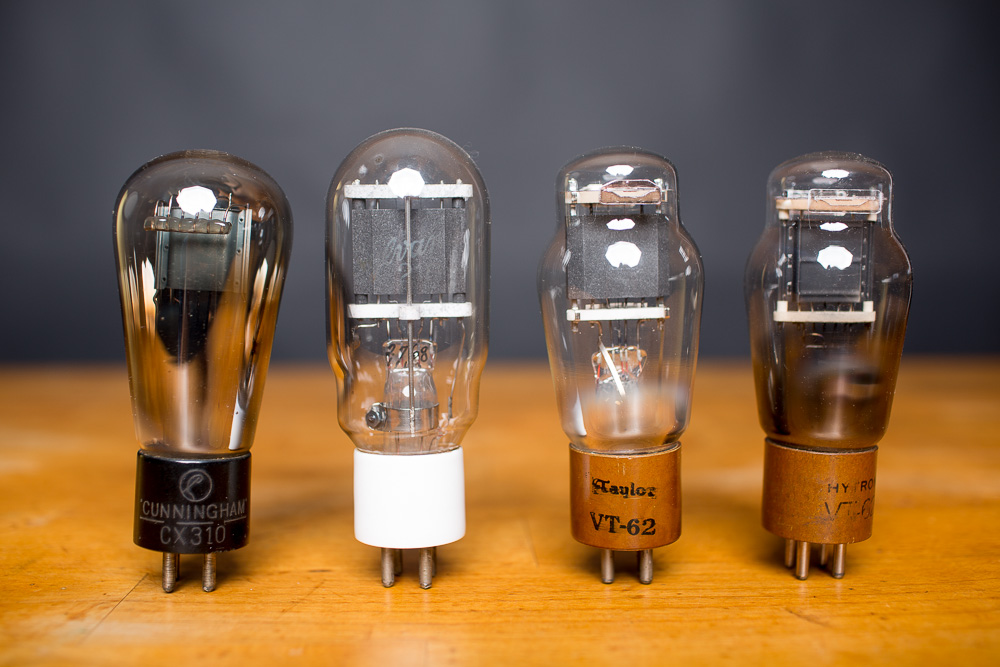
|
||||||||
|
The Type 10, 10Y, UX210, CX310, VT-25, 801a, VT-62. Wow, that's a lot of type designations! This is a very early tube, one of the first amplifiers. Dating to 1925, the 10 makes a whopping 1.5 watts of some of the most clearly articulate and dynamic single ended power ever created. From left to right, a 1920’s Cunningham CX310, a 1920’s Sylvania 210, 1930's Taylor and 1960's Hytron 801a/VT62. The CX310 is the clear winner here sound wise, and is probably my favorite tube in the entire collection. The 801a versions also sound amazing and are capable of much higher power output than the 10Y, making 8 or so watts in the right circuit. The 10 was widely used as a transmitter as well as an amplifier and the Sylvania tube pictured here, as well as the 801a were industrial, not consumer tubes. Of the four tubes pictured here, only the Cunningham globe was intended for an audio circuit. The later ST glass 10Y also sounds very good, but the 10 globe is in a league of its own. Tube data for the 10 can be found here. |
||||||||
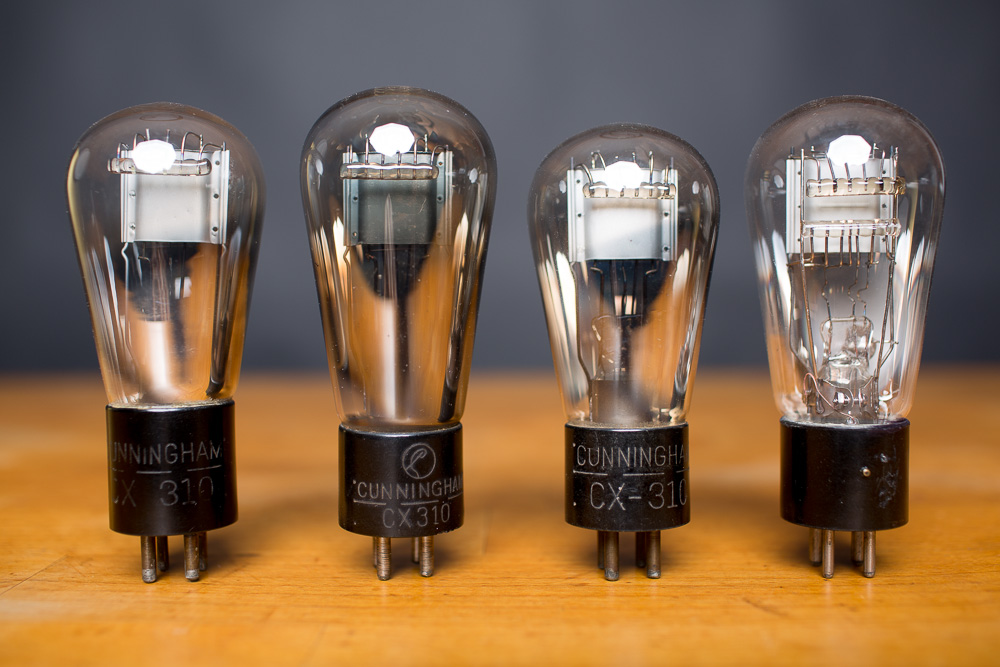
|
||||||||
|
Type 10. A nice assortment of mid-1920's globe 10 tubes, all by Cunningham. The early 10 globe has the very desirable Tungsten filament, and glows as bright as a small lightbulb. In the later ST versions the Tungsten is replaced with an Oxide coated filament. The Oxide tubes sound good, but its the Tungsten filament you want. The Tungsten elevates the fidelity of the tube in really magical ways that are probably impossible to match in a new modern production tube. This is the undiscovered magic of the 1920's captured in a bottle! The downside though is that once the tube has been used and those Tungsten filaments have been heated, they become quite brittle. Especially now that these globe 10 are almost 100 years old caution from physical shock is required. Allow these tubes to cool completely before handling! Of the four I own pictured above, only two have survived. One was killed in transit and another due to handling while hot. I felt it break. Let my expensive mistake be your warning. All that said, this is without doubt one of the best sounding tubes ever created. |
||||||||
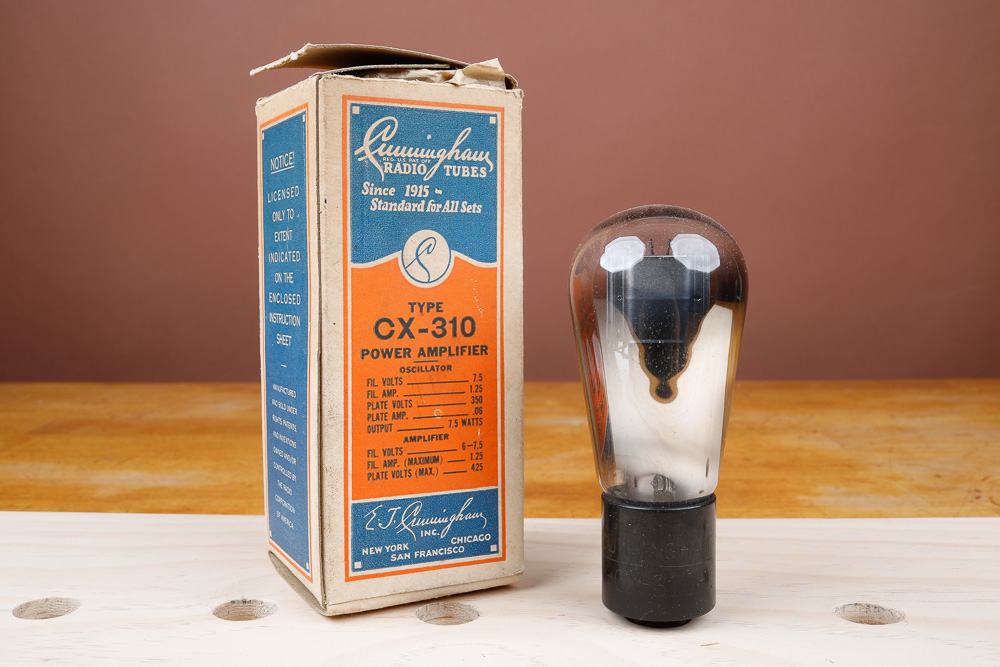
|
||||||||
|
Type 10. Here is a rarity, a Cunningham CX310 new in the box from 1928 or so. |
||||||||
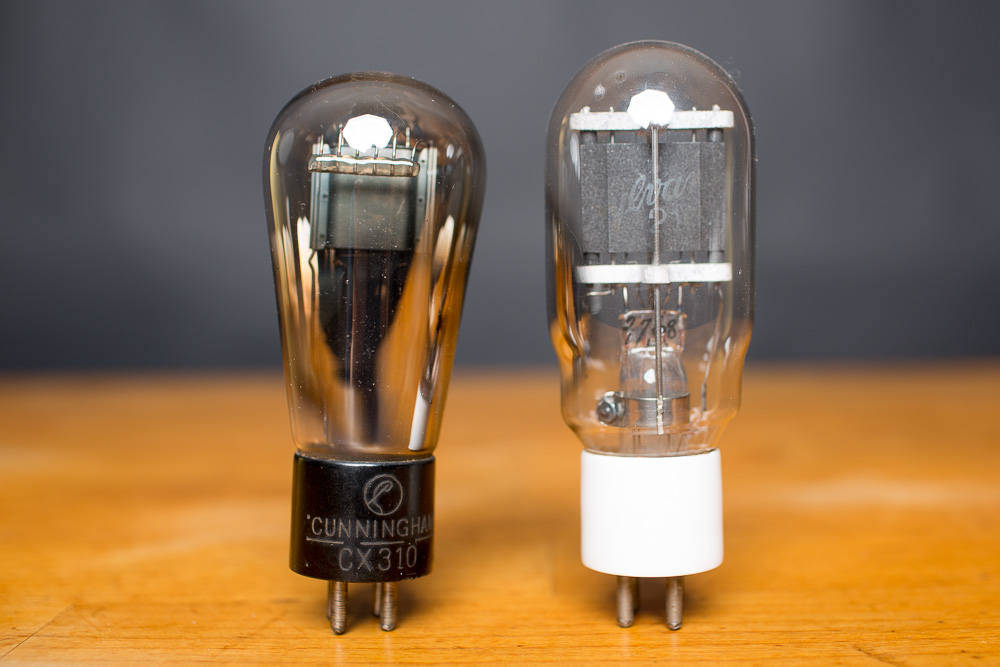
|
||||||||
|
Type 10. Of the same era, late 1920's, one an audio amplification tube for a high-end radio set, another a transmitter tube. |
||||||||
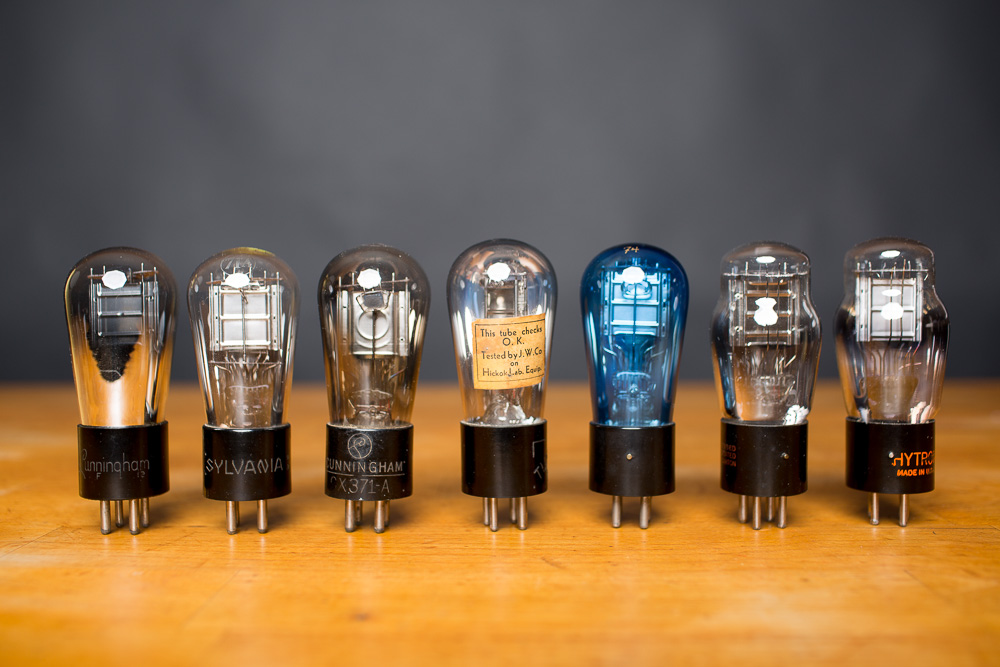
|
||||||||
|
The Type 71a. This very early tube type dates to 1927 and makes 3/4 of one watt of power in a single ended circuit. Within its comfort zone, the 71a is absolutely one of the most musical sounding tubes ever made. The little brother of the 45, these were used in millions of radios from the 1920’s and were still in production until the early 1940s. The 71a has the ability to present a sense of space that is remarkable, and somehow different than its contemporaries. NOS examples of the globe and ST versions of this tube are still fairly plentiful, sometimes in their original cartons, and sound very good. Tube data for the 71a can be found here. |
||||||||
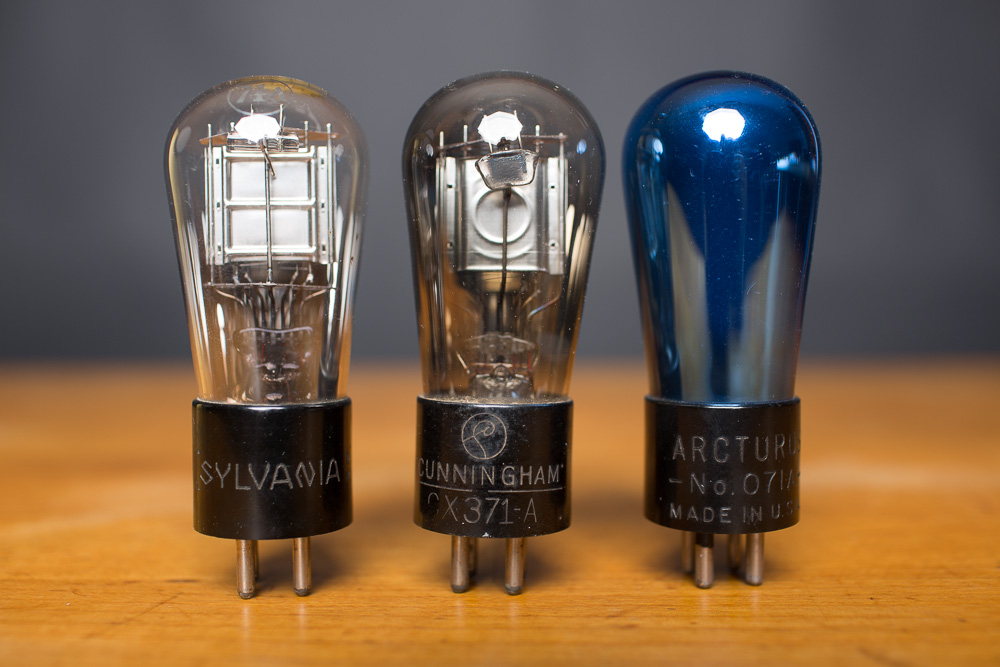
|
||||||||
|
71a. Three globe shaped 71a tubes, by Sylvania, Cunningham and Arcturus. As is common in tubes of this era, each manufacturer has its own unique designation for the tube type, with Sylvania being an SX-171-A, Cunningham had the CX371-A and Arcturus was No.071A (RCA invented the tube and claimed UX-171a, with UX being the designator of the new four pin UX-4 tube socket). These are all 1920's tubes. Of the three I think the Arcturus is the better sounding (and looking) tube. The early Arcturus tubes always sound good to me; I think they must have been a high spec tube manufacturer to sell a blue glass tube in an era where the tube was hidden away in a cabinet and never even seen by the consumer. |
||||||||
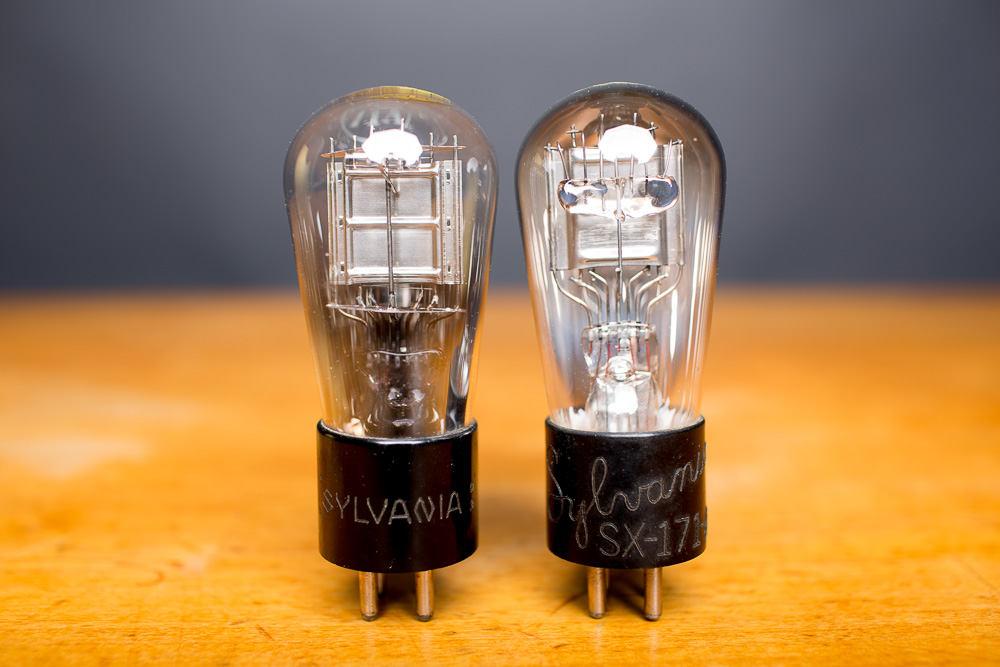
|
||||||||
|
71a. Quite a bit of difference in Sylvania's production. I'd guess the tube on the right is an earlier version and probably one of the earliest 71a made. |
||||||||
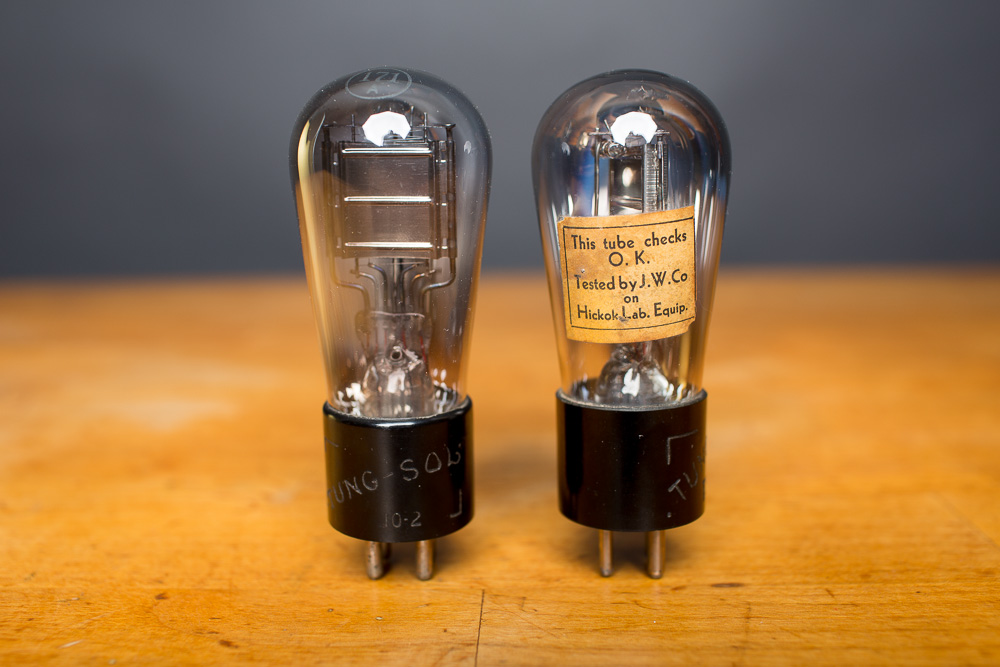
|
||||||||
|
71a. Early Tung Sol engraved base. The test labels on some of the early tubes are a cool feature. |
||||||||
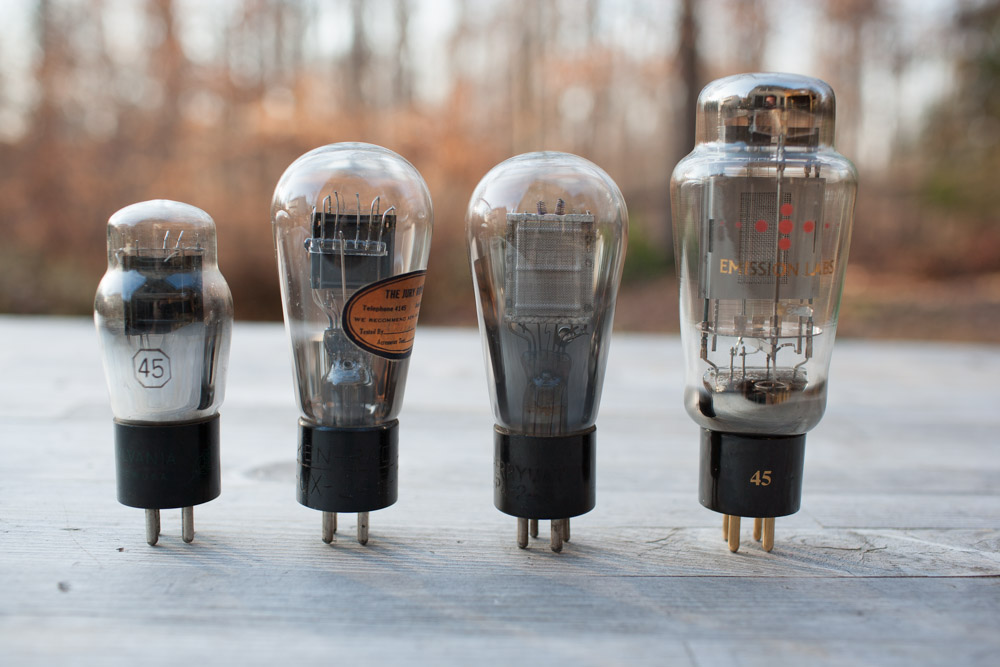
|
||||||||
|
The Type 45. This very early tube type dates to 1929 and makes the biggest and boldest 1.5 watts of single ended power known to man. This tube type kicks ass and is probably the ultimate triode from the standpoint of its superb fidelity combined with the sheer numbers of superb old stock tubes still available. And this tube has been reinvented, with a number of good quality current production tubes that continues to grow in variety, with mesh plates, globes, who knows what…the future is bright for the 45. This tube sounds wonderful and will be around for a long time. Most of the original 45 tubes out there are ST shaped, the globe ended production in the early 1930s. As seems typical with these ancient tube types, the globe shape does sound more open and transparent to me, while the ST shape has more "slam" and body. The 45 is certainly one of the best sounding tubes of all time and has become an audiophile classic. Tube data for the 45 can be found here. |
||||||||
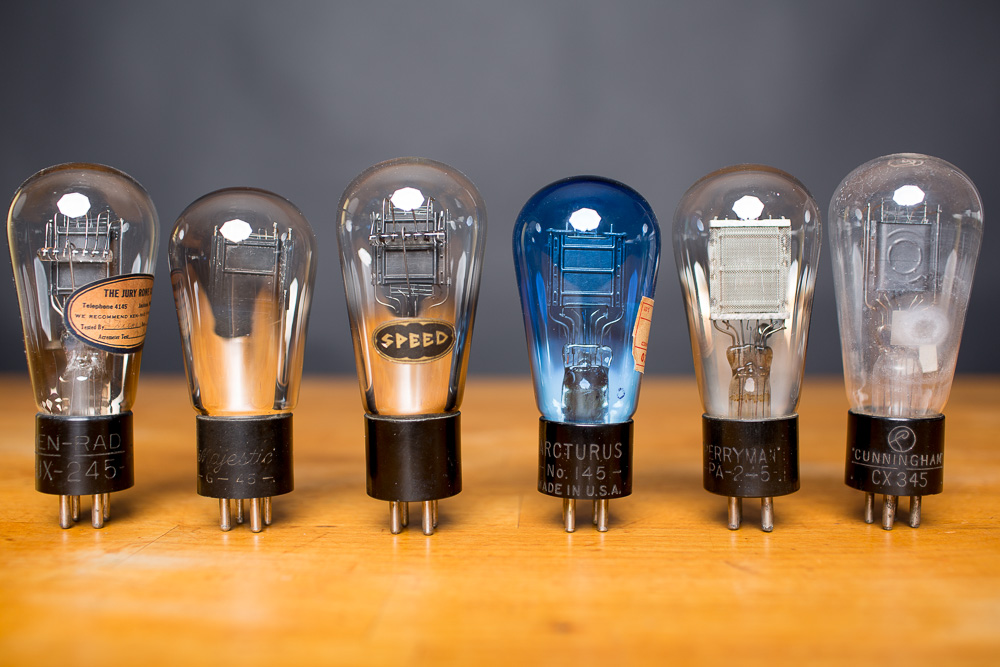
|
||||||||
|
45. A great assortment of early 1930s globe 45 tubes. Here we have one of Ken-Rad’s first tubes, the UX-245, a Majestic G45, Speed’s 145, an Arcturus blue glass No. 145, the amazing and super rare Perryman mesh plate PA245 and finally a Cunningham CX345. Notice the plates are slanted on the Majestic tube. This is the result of many decades of being stored on its side without moving; globe tubes have no support micas and gravity eventually takes it’s toll. |
||||||||
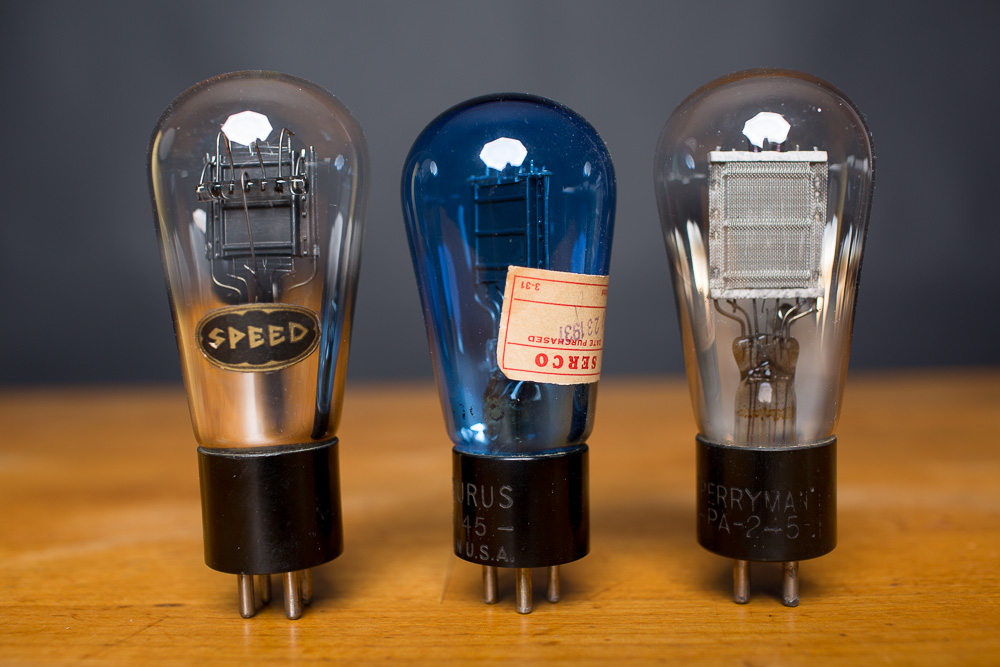
|
||||||||

|
||||||||
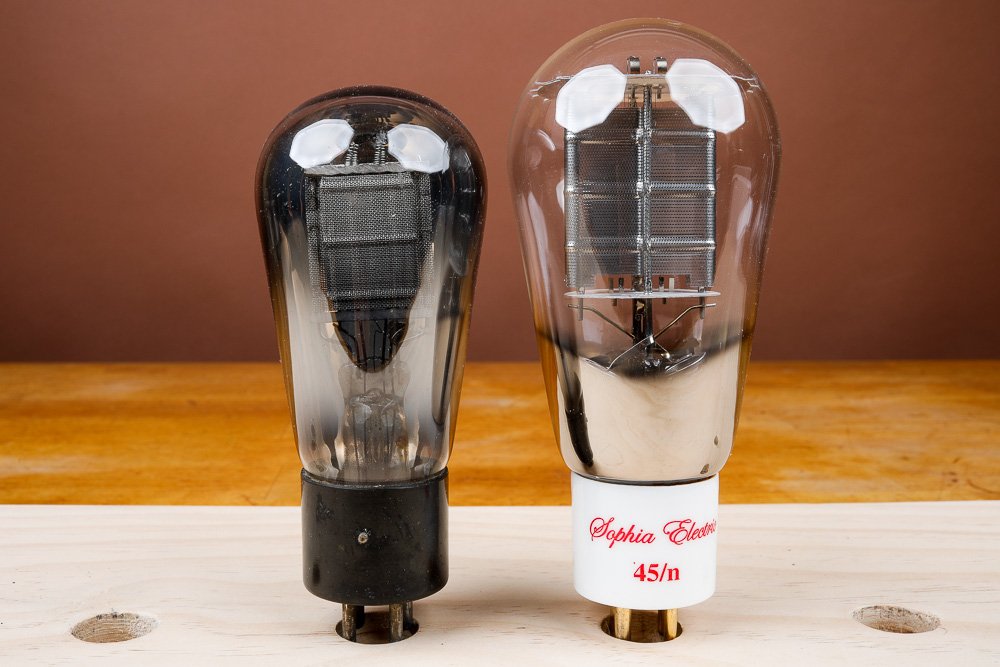
|
||||||||
|
45. Mesh plate 45. The Perryman has a woven mesh plate and the modern Sophia "mesh" is actually a perforated plate rather than being woven. Both sound very good, but the Perryman is a little more magical and is probably the best sounding 45 ever made. |
||||||||
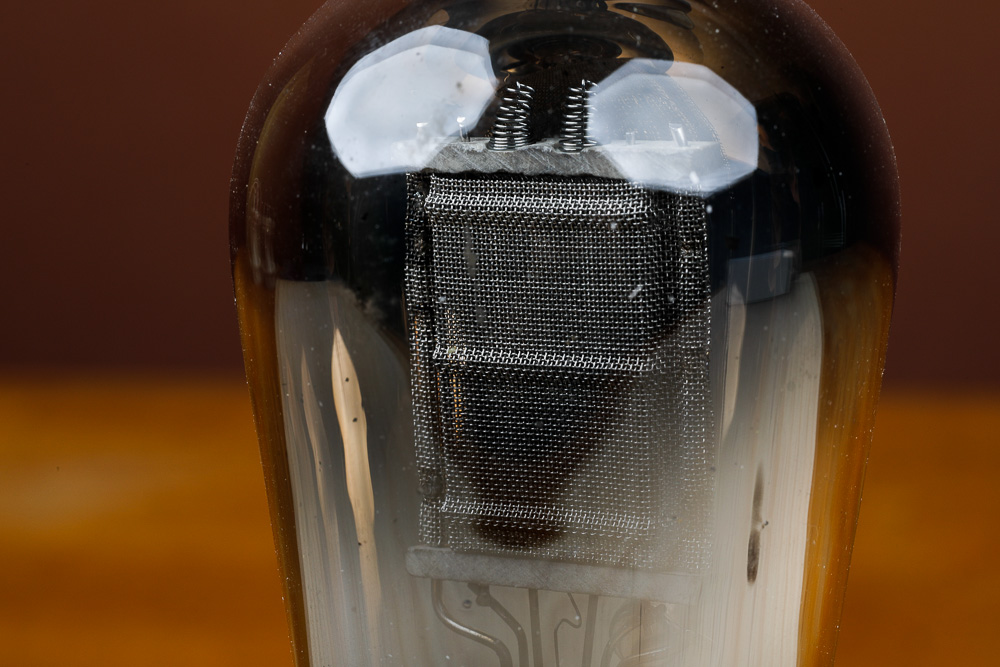
|
||||||||

|
||||||||
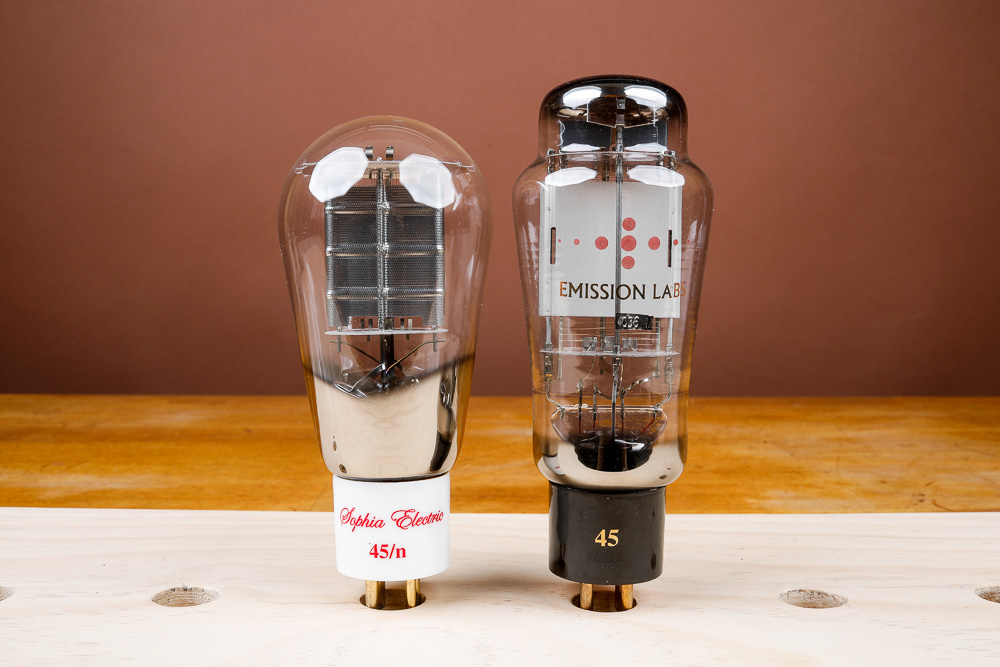
|
||||||||
|
45. Mesh plate 45. A pair of modern 45 tubes, the Chinese-made Sophia mesh 45 and the Czech-made Emission Labs 45. Its hard to overstate the build quality of the Emission Lab tubes. |
||||||||
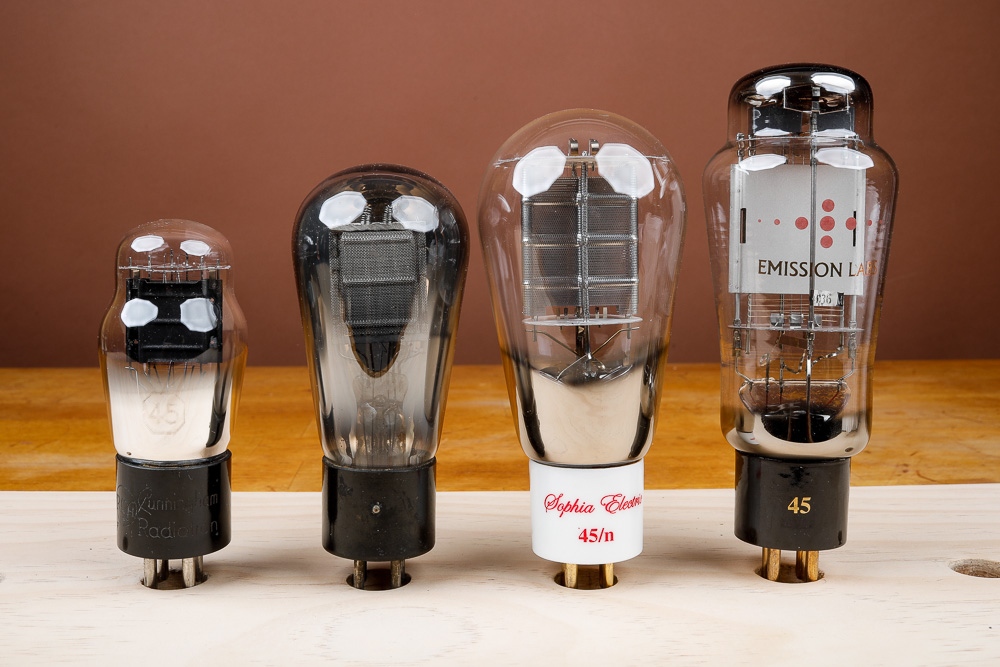
|
||||||||
|
45. The 45 family tree. |
||||||||
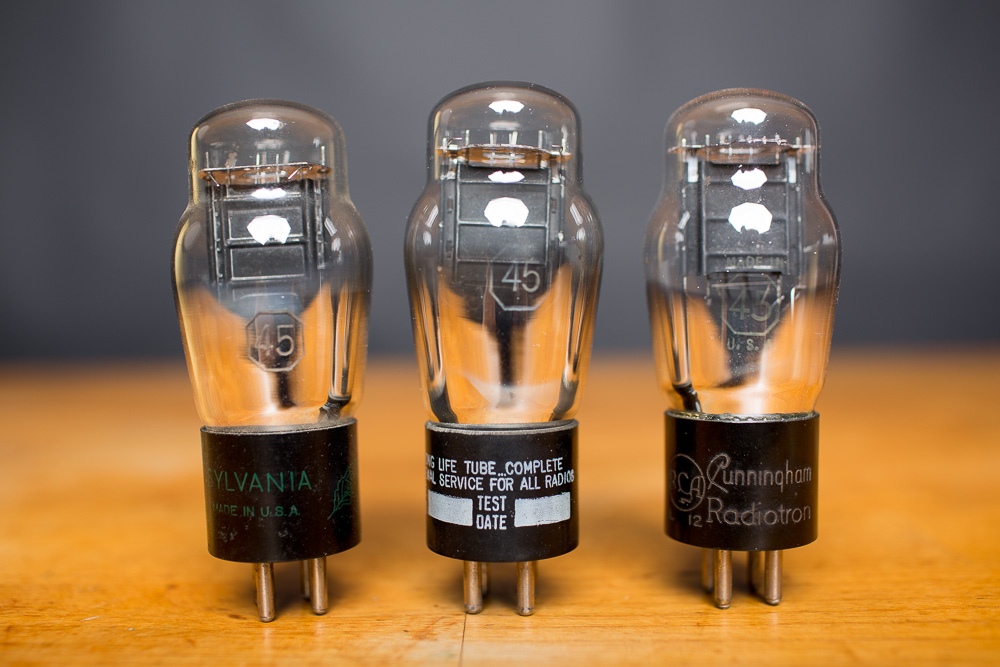
|
||||||||
|
45. ST 45 are great tubes, with a bit more authority than the globe shaped tubes. The RCA Cunningham engraved base tube on the right is an early 1930's tube. |
||||||||
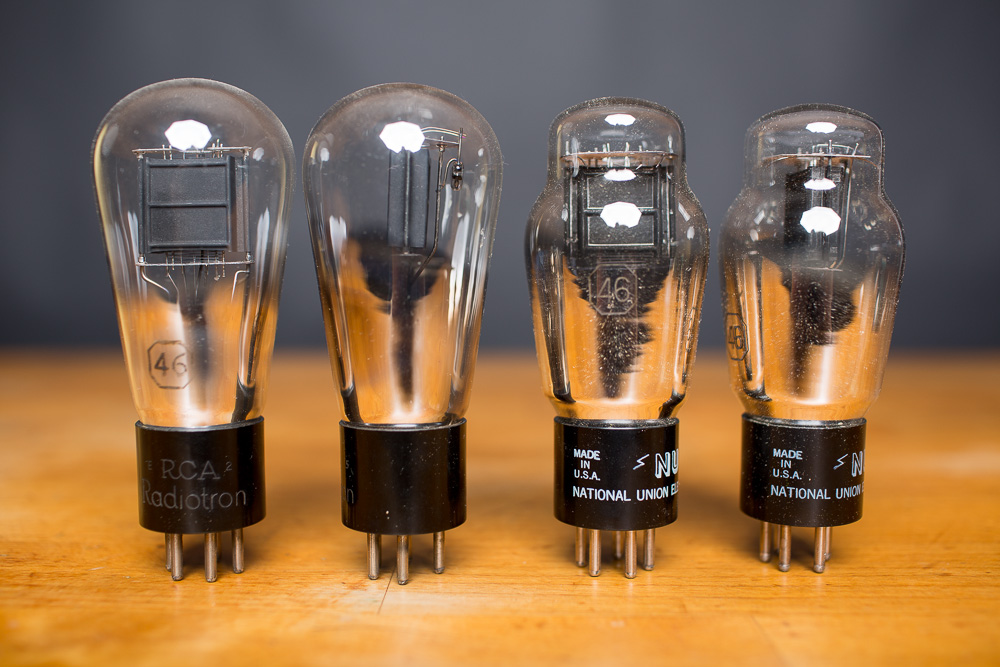
|
||||||||
|
46. The 46 is a strange tube, a “dual grid power amplifier tube” that is actually meant to be run as a triode, this tube was made for industrial amplification in a same-drives-same configuration, almost like a Sakuma design. Used this way the 46 in push pull could make 20 watts of low distortion Class B power. 90 years later its finally found favor in the hifi community, who have recognized it's flat out amazing sound in single ended applications. What a good thing that this tube was “rediscovered”! This one dates to 1932 or so. Tube data for the 46 can be found here. |
||||||||
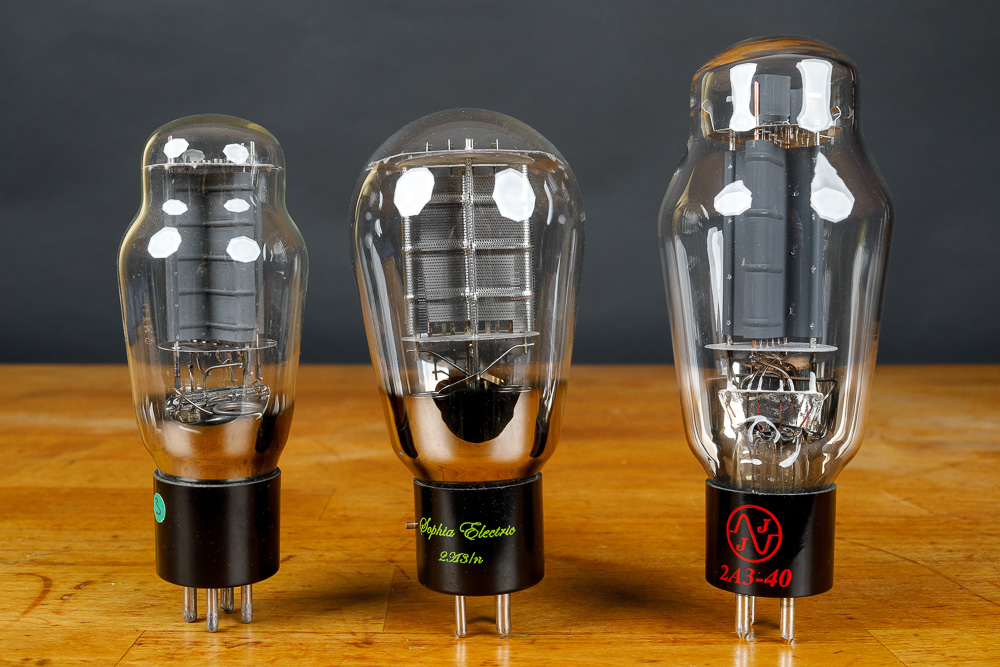
|
||||||||
|
2A3. The 2A3 is one of the greatest tubes of all time, and is the very definition of hifi, being the power tube of the device that was first labeled with that title, RCA’s 1935 D-22 with push pull 2A3 power. The 2A3 dominated the high-end radio market of the 1930's, and was reportedly Paul Klipsch's favorite tube. E.H. Scott loved it enough to include 12 of them running in push-pull in his amazing 1935 Quaranta Amplifier. The 2A3 served an industrial role as well, and was common in US Military regulated power supplies during and after WW2. The 2A3 dates to 1932 or so, but was in production until the 1980's. There's a reason, it’s a beautiful sounding tube. Tube data for the 2A3 can be found here. |
||||||||

|
||||||||
|
2A3. A roundup of 2A3 tubes. Starting with a Ken-Rad tube likely from the 1940’s, an early 2000’s Sovtek Reflektor 2A3 (which is sonically the best of the lot here in my experience), Sophia’s mesh plate globe, JJ’s massive 2A3-40 and a Belgian 6B4G tube, which is actually just a 2A3 with a different base. |
||||||||
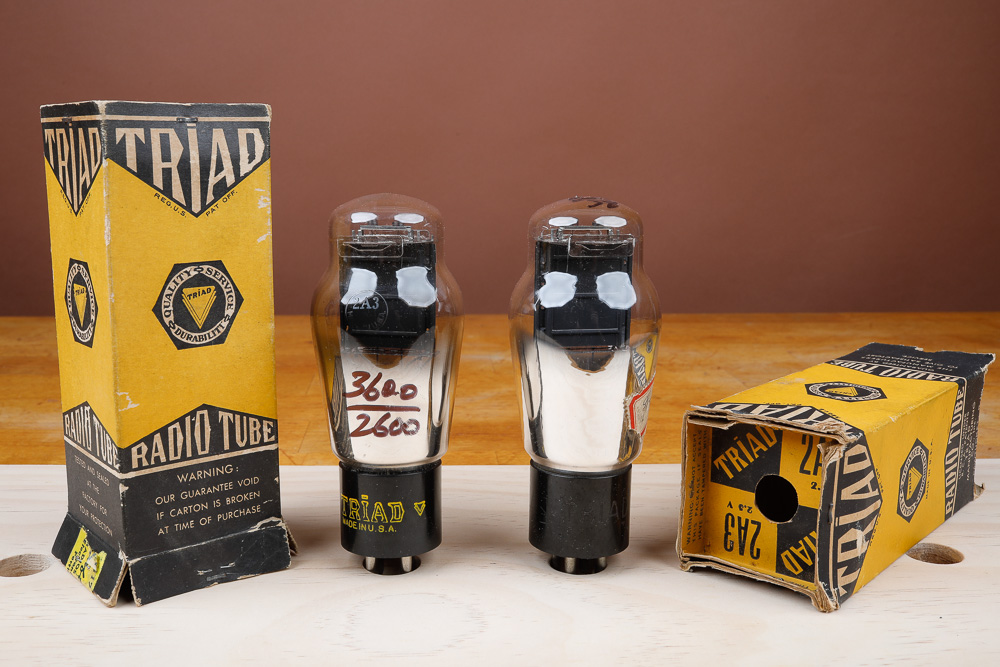
|
||||||||
|
2A3. Prized possessions, a pair of new in the box mono plate 2A3 from Triad. These are incredible tubes. |
||||||||
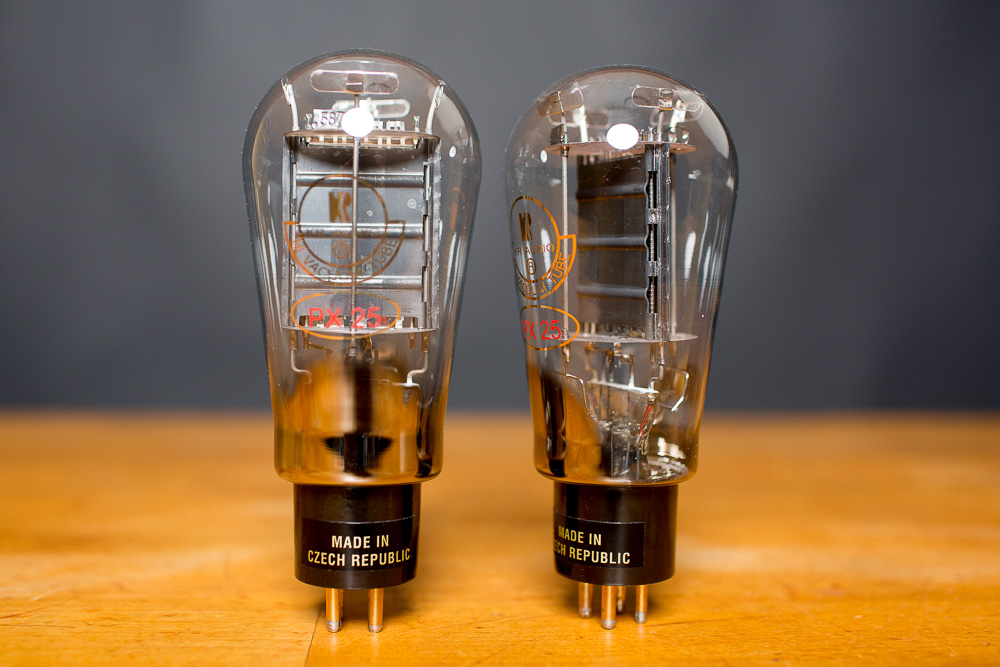
|
||||||||
|
PX25. The PX25 is a British tube and is sort of the English answer to the 2A3 with about twice its power. Tube data for the PX25 can be found here. |
||||||||
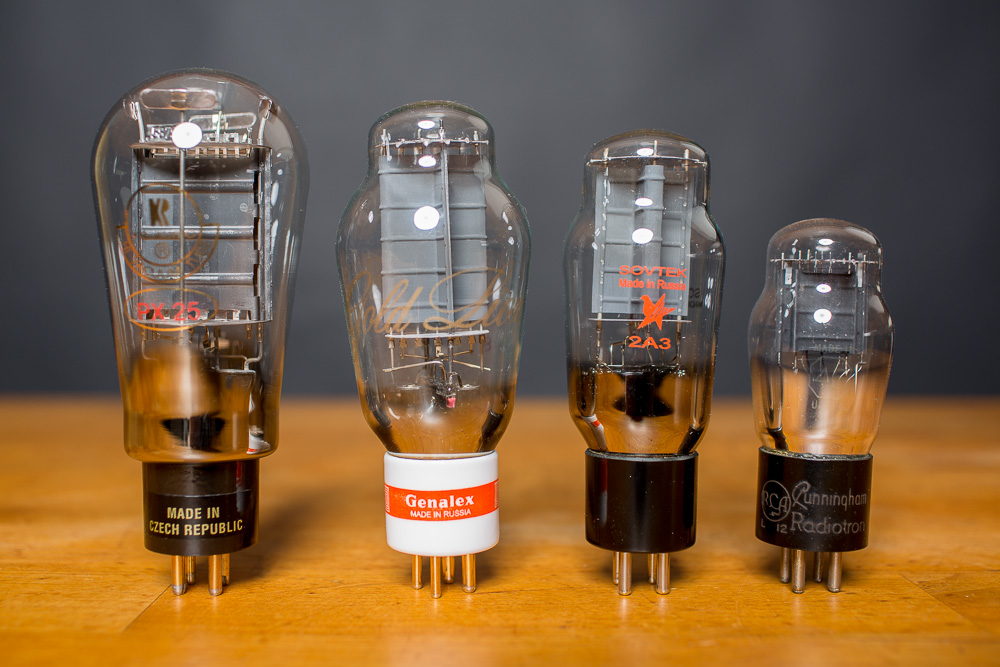
|
||||||||
|
A comparison of some Triode contemporaries: the modern production Czech KR PX25, the Russian Genelex Gold Lion 300B, Russian Sovtek 2A3, and finally a 1930's USA RCA/Cunningham ST 45. An audio Baskin Robbins of Triode flavors. |
||||||||
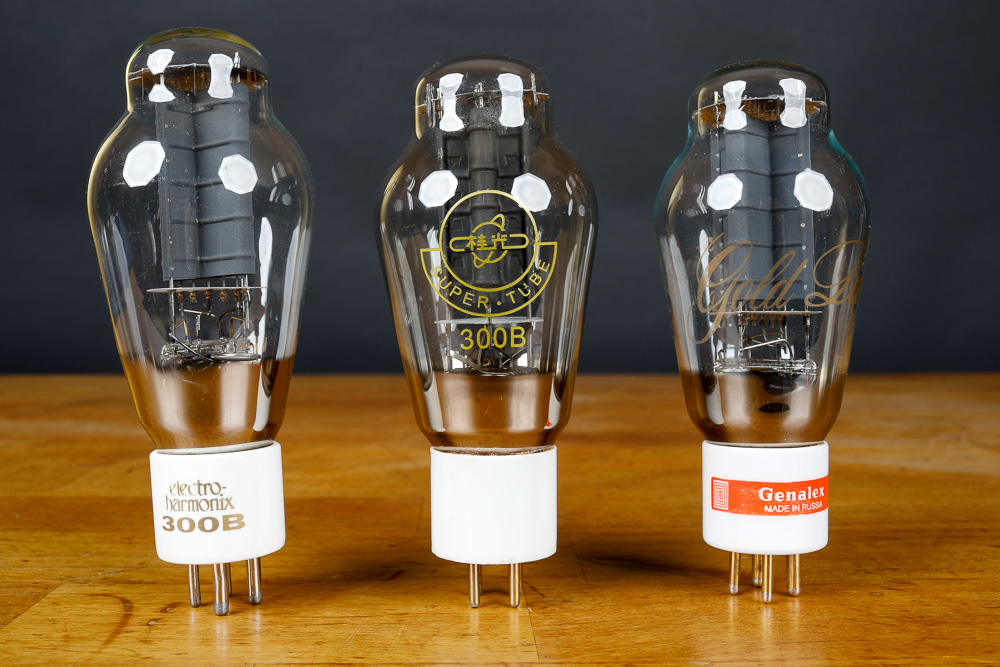
|
||||||||
|
300B. The 300B is the most well-known and revered member of the Triode family of tubes. Here we have a Czech made Electro Haronix Gold Grid, a Chinese made GuiGuang, and a Russian “Gold Lion”. Surprisingly, to me anyway, the GuiGuang tube sounded best to me in Alan Eaton’s 300B monos. Making a whopping 6-8 watts of power in single ended, the 300B can meet the needs of most speakers and still have that lit-from-within feeling. This was never a consumer tube, it was developed by Western Electric for long distance telephone and saw service all over America with Ma Bell, with original production into the 1980’s. It’s an expensive tube, NOS Western Electric versions are priced like a pretty good used car in 2020. Even in new production, the 300B is expensive. It can be very good sounding in the right circuit, and has been a happy ending for many an audiophile, although I think the lower power tubes outclass the 300B in most every respect. Those tubes require efficient speakers to really appreciate, and in my opinion the slightly higher power is the one and only real strength of the 300B over a tube like the 45 or the type 10. Tube data for the 300B can be found here. |
||||||||
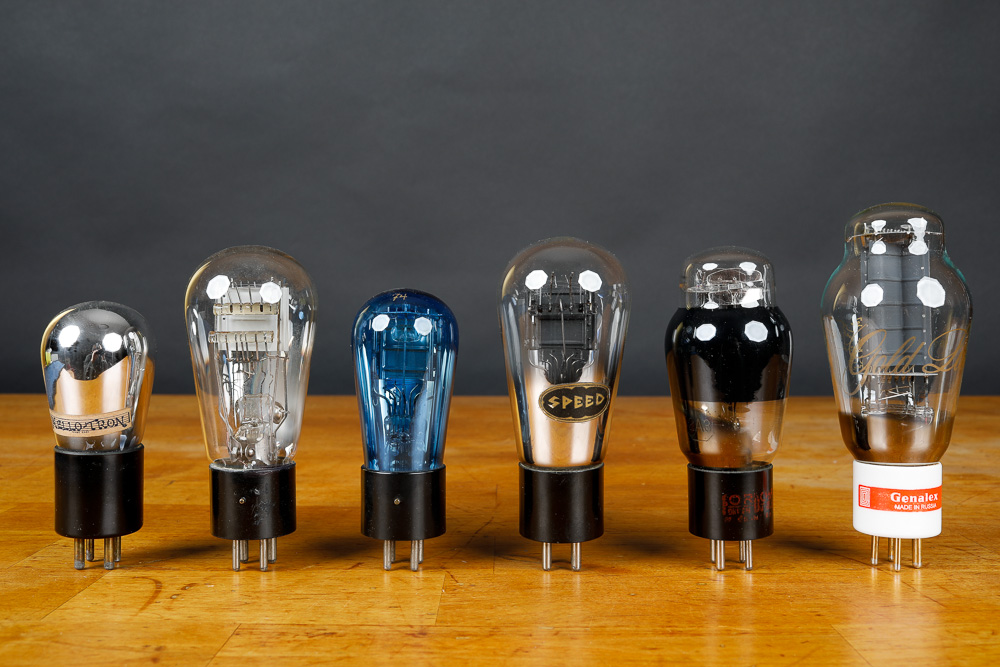
|
||||||||
|
The Triode family, from the first 01a and the type 10 of 1924 and 1925 to the 300B from 1938 (here as a a modern reproduction). |
||||||||
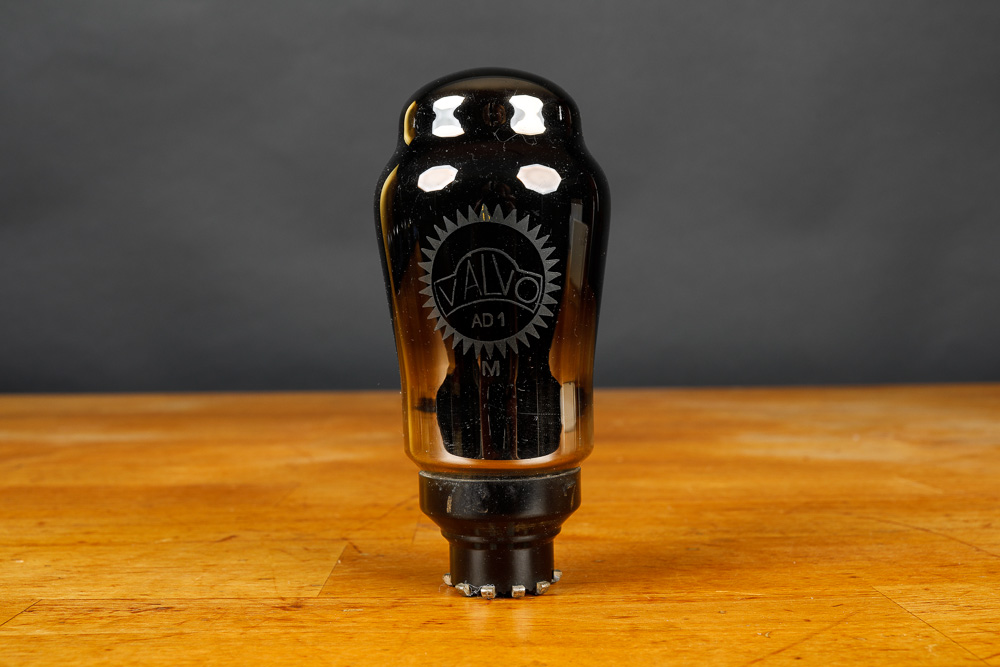
|
||||||||
|
AD1. The AD1 is a European triode dating to the 1930’s and is sort of the European equivalent to the 2A3. It was only made in small numbers just before the Second World War, and after the War it became prohibitively expensive to produce and not many were made in total. It does sound magnificent; having warmth, tone, a sense of space and an effortlessness presentation. Tube data for the AD1 can be found here. |
||||||||
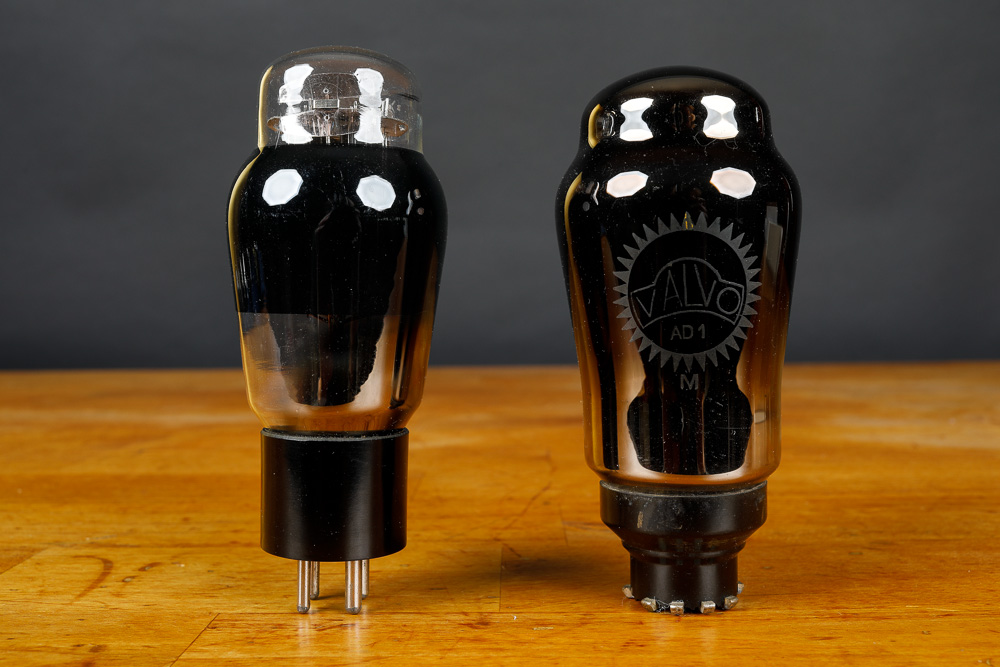
|
||||||||
|
The AD1 and its American contemporary, the 2A3. |
 |
|||||||
 |
 |
 |
 |
 |
|||
 |
|||||||
 |
|||||||